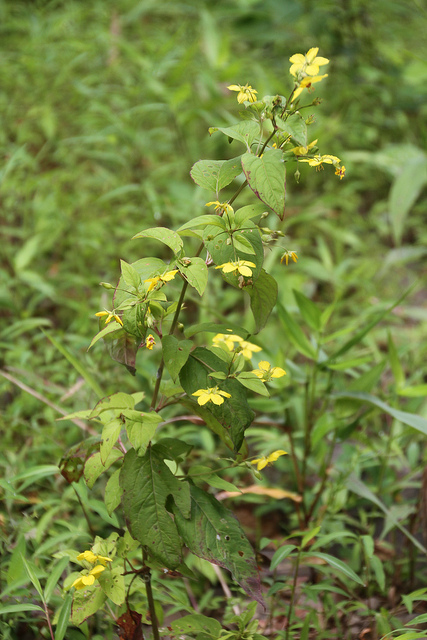Map Snapshot

















179 Records
Relationships
Host plant for Blurry-patched Nola Moth.
Seasonality Snapshot
Source: Wikipedia
| Fringed loosestrife | |
|---|---|

| |
| Flower | |
| Scientific classification | |
| Kingdom: | Plantae |
| Clade: | Tracheophytes |
| Clade: | Angiosperms |
| Clade: | Eudicots |
| Clade: | Asterids |
| Order: | Ericales |
| Family: | Primulaceae |
| Genus: | Lysimachia |
| Species: | L. ciliata
|
| Binomial name | |
| Lysimachia ciliata | |
| Synonyms | |
|
Steironema ciliatum | |
Lysimachia ciliata, the fringed loosestrife, is a species of flowering plant in the family Primulaceae. It is an erect herbaceous perennial growing to 120 cm (47 in) tall and 60 cm (24 in) broad, with opposite, simple leaves, and smooth green stems. The star-shaped yellow flowers are borne in midsummer.[1] It is native to North America, including most of southern Canada and most of the United States except for the southwest. This plant is notable in that it is one of the few species of Lysimachia to bear elaiophores, that is, to offer oil instead of nectar as a reward to pollinators. It is pollinated in the northern part of its range by the specialist oil bee Macropis nuda, a native bee species whose survival depends upon this host plant.[2]
It is also cultivated as an ornamental plant. It can be aggressive, but new suckers can be removed easily to keep plant size under control. The most common cultivars of L. ciliata include:
- L. ciliata 'Firecracker'
- L. ciliata 'Purpurea'
'Firecracker'[3] has gained the Royal Horticultural Society's Award of Garden Merit.
References
[edit]- ^ RHS A-Z encyclopedia of garden plants. United Kingdom: Dorling Kindersley. 2008. p. 1136. ISBN 978-1405332965.
- ^ M.A. Buckner, B.N. Danforth (2022) Climate-driven range shifts of a rare specialist bee, Macropis nuda (Melittidae), and its host plant, Lysimachia ciliata (Primulaceae). Global Ecology and Conservation37: e02180, ISSN 2351-9894, https://doi.org/10.1016/j.gecco.2022.e02180
- ^ "Lysimachia ciliata 'Firecracker'". RHS. Retrieved 29 October 2020.
External links
[edit]- USDA Plants Profile forLysimachia ciliata (fringed loosestrife)
- Lysimachia ciliata — U.C. Photo gallery
















